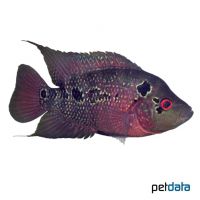Flowerhorn Cichlid (Cichlidae sp. 'Flowerhorn')
| Flowerhorn Cichlid Cichlidae sp. 'Flowerhorn' | |
|---|---|
| Name | Flowerhorn Cichlid |
| Name Lat. | Cichlidae sp. 'Flowerhorn' |
| Synonym | Lou Han Cichlid |
| Family | Cichlids |
| Family lat. | Cichlidae |
| Order | Cichlids |
| Order lat. | Cichliformes |
| Origin | Hybrid breeding |
| Habitat | Aquarium |
| Diet | Carnivore |
| pH | 6.5-8.0 |
| Behavior | Aggressive |
| Keeping | Individual, pair |
| Care Level | Moderate |
| Reproduction | Substrate spawner |
| Breeding | Difficult |
| Life Span | 10-12 years |
| Protection | No |
| Metric Units | |
| Size | 30 cm |
| Temperature | 24-28 °C |
| Hardness | 10-20 °dH |
| Aquarium | ~ 500 l |
| US Units | |
| Size | 12" |
| Temperature | 75-82 °F |
| Hardness | 178-356 ppm |
| Aquarium | ~ 130 gal |
Distribution and habitat
Flowerhorn are hybrids first bred in Malaysia by crossing various South and Central American cichlids and consistent breeding selection. Flowerhorn do not occur in the wild. Today there are several Flowerhorn breeding lines, mainly from breeding farms in Malaysia, Thailand, Vietnam and Indonesia.
Maintenance
They need a well structured aquarium with stones and roots (hiding places) and sufficient swimming space. A deep, sandy substrate for burrowing, subdued light (floating plants) and medium to hard water is ideal.
No ammonia, ammonium or nitrite should be detectable, and the nitrate value should not exceed 100 mg/l. To ensure the water quality and oxygen content, a filter and heater adapted to the aquarium size is required, as well as lighting for the species-appropriate day-night rhythm of the animals.
Diet
The food offer consists of a high-quality, protein-rich dry food for cichlids (pellets, granules), supplemented with live or frozen food, such as mysis, krill, shrimp with shell, brown shrimp, etc., or a frozen, vitamin-enriched special food mix for large cichlids. Adult animals can also be offered earthworms or crickets
It is recommended to feed them several times a day. Only feed as much as will be eaten within a few minutes. Regular and varied feeding promotes health and increases resistance.
Behaviour and compatibility
They are very aggressive within the species and towards other fish and should be kept singly. Pair keeping is only recommended in a much larger and richly structured tank. They can only be socialized with large and defensible fish. Fish that are too small are considered prey
Basically, only compatible fish species with similar demands on water condition and water temperature may be socialized.
Sex dimorphism
Males are stronger, have longer, more pointed dorsal and anal fins, and a larger frontal hump. With some experience, the sexes can be distinguished by their genital papilla, which is thinner and longer in the male.
Reproduction and breeding
Breeding is difficult due to their aggressiveness. They are free spawners, which spawn on a stone plate or also on the aquarium bottom. Both parents perform intensive brood care (parental family) and defend the territory emphatically. After 3-5 days the fry hatch and are then housed and guarded in a prepared bottom pit until they swim freely after 4-6 days. If there are not sufficient hiding places for the female, she often has to be separated from the hyperaggressive male
Juveniles must be fed several times a day with special rearing food (e.g. Artemia nauplii).
Important
There are numerous flowerhorn breeding varieties and breeding lines.
They rummage through the substrate in search of food. Accordingly, stone structures must be very stable. Plants should be placed in heavy pots and secured with stones against burrowing, but planting is not necessary.
The well-being of the fish should be checked regularly. Temperature should be checked daily, pH, hardness and nitrate levels at least every 14 days. Regular partial water changes are recommended, even if the contaminant level has not yet reached the upper limit. Sudden changes in water quality should be avoided. Newly introduced fish must be accustomed slowly to the water in the aquarium.
Further literature can be found in your pet store.
References
Text: Werner Winter; Image: petdata
Source: BMEL (1998): Tierschutzgutachten - Haltung von Zierfischen (Süßwasser); ENGELMANN (2005): Zootierhaltung - Tiere in menschlicher Obhut: Fische, Verlag Harri Deutsch
- Gemäß § 21 Abs. 5 Tierschutzgesetz idgF
